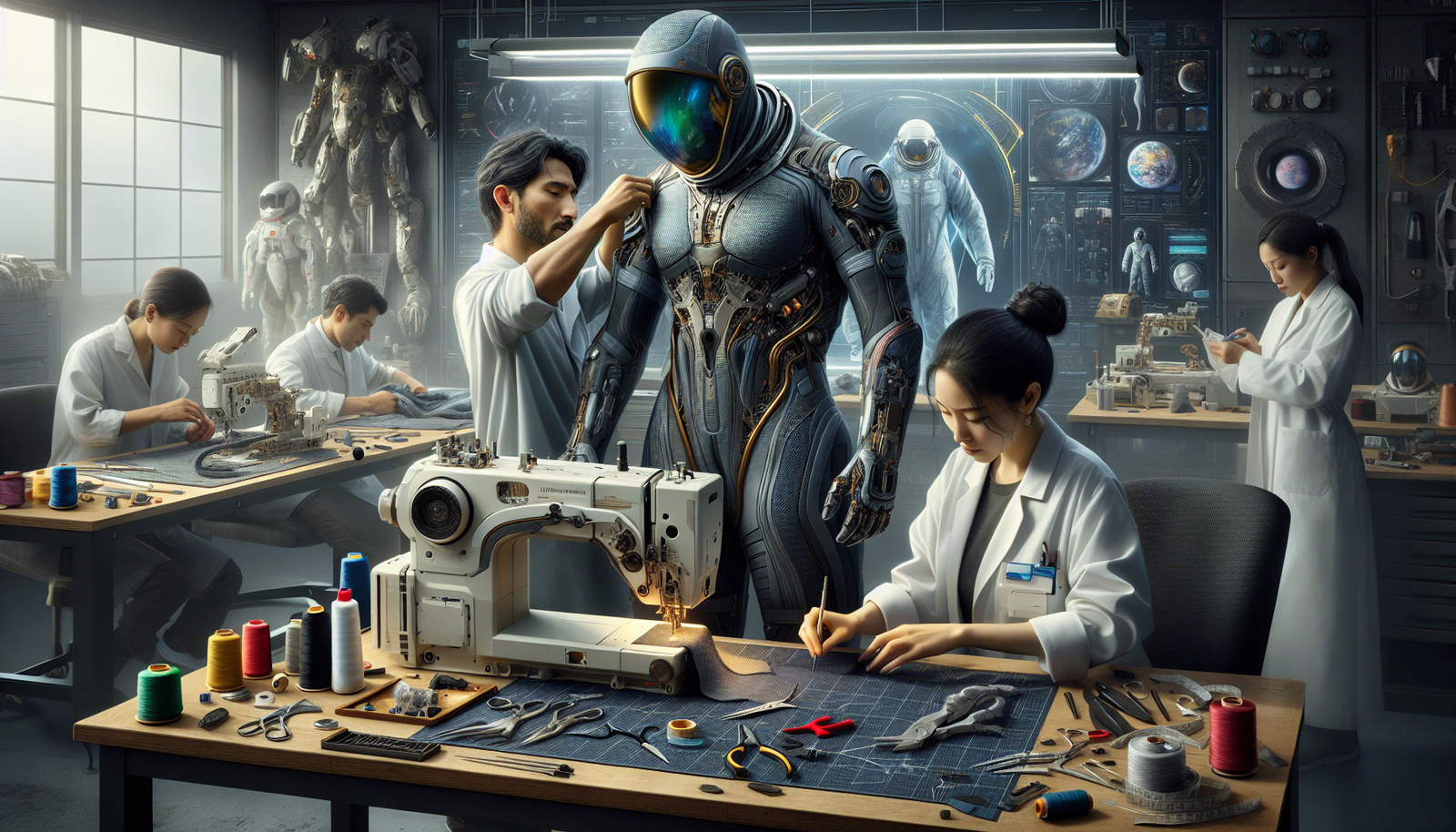Tailoring Space Suits
Imagine the incredible skill and precision required to tailor space suits that are specially designed for astronauts! From the intricate stitching to the selection of durable and flexible materials, space suit tailoring is an art form that combines functionality and craftsmanship. Each suit is custom-made to ensure a perfect fit and maximum comfort, while also providing the necessary protection for astronauts in the extreme conditions of outer space. As technology advances and space exploration continues to push boundaries, the importance of tailoring space suits cannot be underestimated.
Space Suit Tailoring
Space exploration has been a fascination for humanity for centuries. As humans venture further into the unknown depths of space, the importance of tailoring space suits becomes crucial. A well-tailored space suit not only ensures the safety and well-being of astronauts but also enhances their performance during missions. This article will delve into the evolution of space suits, the challenges in tailoring them, the materials used, design considerations, comfort, customization, tailoring for different environments, and future trends in space suit tailoring.
Importance of Tailoring Space Suits
Ensuring Proper Fit
When it comes to space suits, proper fit is of utmost importance. Astronauts spend long periods of time wearing these suits, and a poorly fitted suit can cause discomfort and even pose risks to their health. Tailoring space suits to fit each astronaut’s unique body shape and size ensures optimum comfort and prevents any restricted movement during critical tasks.
Enhancing Performance
A well-tailored space suit can significantly enhance an astronaut’s performance. The ability to move freely and comfortably is crucial for completing tasks efficiently in the challenging environments of space. Tailoring space suits allows for a better range of motion, improving dexterity and reducing the physical strain on astronauts, leading to increased productivity and safety.
Reducing Health Risks
Space travel presents numerous health risks, such as temperature fluctuations, radiation exposure, and the physiological effects of microgravity. Properly tailored space suits can help mitigate these risks. By providing thermal insulation, radiation protection, and maintaining life support systems, tailored space suits minimize the potential harm to astronauts and increase their chances of a safe return to Earth.
Evolution of Space Suits
Early Space Suit Designs
The development of space suits traces back to the early days of space exploration. The first space suits were bulky and had limited mobility, mainly designed for protection against extreme temperatures and pressure changes. These suits were often custom-made for each astronaut, focusing more on functionality than comfort.
Manned Space Missions and Suit Improvements
As manned space missions became more frequent, advancements in space suit design followed suit. The Apollo program introduced suits that allowed astronauts to maneuver more freely, with improvements in mobility and life support systems. These advancements paved the way for milestone achievements, such as the first moon landing, and opened new possibilities for space exploration.
Modern Space Suit Designs
In recent years, space suit designs have continued to evolve, with a focus on lightweight materials, increased flexibility, and improved safety features. Modern space suits incorporate advanced technologies to enhance astronauts’ comfort, mobility, and overall performance. These suits are ergonomically designed, taking into account anthropometric measurements, gender-specific tailoring, and customized features for individual astronauts.
Challenges in Space Suit Tailoring
Extreme Environments
Space presents one of the harshest environments for human exploration. The challenges faced in tailoring space suits lie in protecting astronauts from extreme temperatures, pressure differentials, and microgravity conditions. Space suit designers must ensure that the suits can withstand these extreme conditions while maintaining the health and well-being of astronauts.
Microgravity Considerations
Microgravity poses unique challenges when it comes to space suit tailoring. Astronauts require suits that allow them to move freely in a weightless environment while also providing the necessary support and stability. Achieving a balance between maneuverability and structural integrity is a complex task for space suit designers.
Protection against Radiation
Astronauts are exposed to higher levels of radiation in space compared to those on Earth. Space suit designers must incorporate radiation shielding materials into the suits to minimize the harmful effects of radiation exposure. Balancing the weight and effectiveness of these materials is a critical challenge in space suit tailoring.
Balancing Durability and Flexibility
Space suits need to withstand the harsh conditions of space while providing the necessary flexibility for astronauts to perform tasks. Finding the right balance between durability and flexibility is a constant challenge. The suits must be resistant to tears, punctures, and degradation, while still allowing for a wide range of motion and tactile sensitivity.
Maintaining Life Support Systems
Space suits act as mini spacecraft, providing astronauts with a controlled environment to survive in space. These suits must maintain life support systems, such as oxygen supply, temperature regulation, and waste management, for extended periods. Incorporating these systems into the suits while ensuring their reliability and efficiency adds another layer of complexity to space suit tailoring.
Materials Used in Space Suits
Layers of Space Suit Materials
Space suits typically consist of multiple layers of various materials. These layers include an outer shell for protection, thermal insulation materials for temperature control, pressure sealing materials, and microfiber fabrics for moisture management. Each layer serves a specific purpose in ensuring the functionality, comfort, and safety of the astronaut.
Outer Shell Materials
The outer shell of a space suit serves as the first line of defense against the harsh environment of space. It must protect against micrometeoroids, temperature extremes, and radiation. Materials such as high-strength fabrics, woven composites, and polymers with specialized coatings are used to provide the necessary protection.
Thermal Insulation Materials
Space is a vacuum, with extreme temperature fluctuations. Thermal insulation materials are used to regulate the temperature inside the space suit. These materials trap air and prevent heat transfer, keeping the astronaut’s body at a comfortable temperature. Some commonly used thermal insulation materials are aerogels, foams, and multilayered insulators.
Pressure Sealing Materials
Maintaining the pressure inside the space suit is crucial for the survival of astronauts in the vacuum of space. Pressure sealing materials are used to create a tight seal between different components of the suit, preventing leaks and ensuring the integrity of the pressurized environment. Elastomeric materials, such as silicone rubber, are commonly used for this purpose.
Microfiber Fabrics for Moisture Management
Moisture management is essential to prevent discomfort, skin irritation, and bacterial growth inside space suits. Microfiber fabrics are used to wick sweat away from the astronaut’s body, keeping them dry and comfortable. These fabrics have a high water absorbency rate, allowing moisture to evaporate quickly.
Flexible Joints and Connectors
Space suits must provide ease of movement and flexibility for astronauts to perform complex tasks. Flexible joints and connectors are essential components in achieving this. These joints and connectors are made from specialized materials, such as reinforced polymers, to ensure durability and flexibility without compromising the overall integrity of the suit.
Advanced Technologies in Space Suit Materials
Advancements in technology have opened up new possibilities for space suit materials. Materials with self-healing properties, electrochromic visors for adjustable tint, and integrated sensors for monitoring vital signs are just a few examples of the cutting-edge technologies being incorporated into space suit materials. These advancements aim to enhance the functionality, comfort, and safety of astronauts during space missions.
Design Considerations
Ergonomics and Range of Motion
Ergonomics plays a vital role in space suit design. Space suits must be tailored to fit the unique body shapes and sizes of astronauts, providing them with optimum comfort and freedom of movement. The design should allow for a wide range of motion, especially in critical areas such as the arms, legs, and torso.
Ease of Donning and Doffing
Space suits are worn and removed multiple times during missions, and the process can be challenging. Designing suits that are easy to don and doff is crucial for efficiency and minimizing the risk of injury. Innovative fastening mechanisms and user-friendly interfaces have been incorporated into modern space suits to streamline this process.
Helmet and Visor Design
The helmet and visor of a space suit are essential components for astronaut safety and visibility. The design of these elements must ensure unobstructed vision, protection against impacts and micrometeoroids, and efficient communication. Lightweight materials, anti-fog coatings, and adjustable visor tint are some of the considerations in helmet and visor design.
Glove and Glove Interface Design
The gloves of a space suit are of utmost importance, as they provide astronauts with the tactile sensitivity required for intricate tasks. Designing gloves that offer dexterity, grip, and protection is a complex challenge. Glove interfaces are crucial in allowing secure connections with tools and equipment while maintaining the integrity of the suit.
Integration of Communication and Sensor Systems
Space suits are not just protective gear; they are also communication hubs and data collectors. Integrating communication systems, such as microphones and speakers, into the suit design ensures efficient and reliable communication between astronauts and mission control. Additionally, sensors embedded in the suit can monitor vital signs, environmental factors, and equipment status for real-time feedback and analysis.
Suit Port Compatibility
Suit ports are entry points into spacecraft or habitats, allowing astronauts to transfer between different environments without compromising the integrity of the suits. Design considerations for suit port compatibility involve creating standardized interfaces that facilitate easy and secure connections while maintaining pressure integrity.
User Interface Design
User interface design is crucial in making space suits more user-friendly and intuitive. Clear and accessible controls, visual indicators, and ergonomic placement of interfaces are key considerations. Providing a user-friendly interface allows astronauts to efficiently interact with the suit’s systems and perform complex tasks with ease.

Ensuring Comfort and Mobility
Pressure Regulation and Mobility Enhancement
Proper pressure regulation inside a space suit is crucial for the comfort and safety of astronauts. Pressure points can cause discomfort and restrict movement. Space suits are designed to distribute pressure evenly, alleviating discomfort and enhancing mobility. Incorporating adjustable pressure settings and enhancing range of motion in critical areas further contribute to astronaut comfort and performance.
Thermal Comfort
Maintaining thermal comfort inside a space suit is essential, as extreme temperatures can pose risks to astronauts’ health. Advanced thermal insulation materials and active heating or cooling systems are employed to regulate temperature, ensuring that astronauts remain comfortable throughout their missions.
Moisture Management
Moisture management is a critical aspect of space suit design to prevent discomfort, skin irritation, and bacterial growth. Sweating inside a space suit can lead to an uncomfortable environment. Microfiber fabrics, moisture-wicking technologies, and breathable materials are used to dissipate moisture and keep the astronaut’s body dry and comfortable.
Reducing Weight and Bulkiness
Reducing the weight and bulkiness of space suits is a continuous endeavor in space suit tailoring. Lightweight materials and compact design elements are incorporated to minimize the strain on astronauts and improve their mobility. Lightweight fabrics, advanced composites, and innovative structural designs contribute to reducing the weight and size of space suits.
Minimizing Fatigue
Space missions can be physically demanding, and fatigue can have a significant impact on astronaut performance. Designing space suits to minimize fatigue involves ergonomic considerations, weight distribution, and support mechanisms. These features help reduce the strain on astronauts’ bodies, enabling them to perform at their best for extended periods.
Customization for Astronauts
Anthropometric Measurements
Astronauts have diverse body shapes and sizes, and tailoring space suits to their specific anthropometric measurements is crucial for a proper fit. Ensuring that the suit molds to the astronaut’s body allows for optimal comfort and mobility during missions. Advanced measurement techniques and 3D scanning technologies aid in precise customization.
Gender-Specific Tailoring
In addition to anthropometric measurements, gender-specific tailoring is an important consideration in space suit design. Men and women have distinct physiological differences that impact the fit and comfort of space suits. Designing suits that accommodate these differences ensures optimal performance and well-being for both male and female astronauts.
Customized Features for Individual Astronauts
Each astronaut has unique requirements and preferences when it comes to space suits. Customized features, such as adjustable components, tailored padding, and personalized interfaces, can be incorporated to cater to individual astronaut needs. These customization options allow for a more personalized and comfortable experience during space missions.
Personalization for Extended Missions
As space exploration moves toward more extended missions, personalization becomes even more important. Space suits must be tailored to accommodate individual astronaut preferences and needs over prolonged periods. Personalized adjustments, such as modular designs, interchangeable components, and customizable life support systems, enable astronauts to adapt to the changing demands of long-duration space travel.

Tailoring for different Environments
Spacewalks and Extravehicular Activities
Spacewalks and extravehicular activities (EVAs) involve astronauts venturing outside the confines of their spacecraft. Suits tailored for EVAs require additional protection against micrometeoroids, temperature extremes, and the harsh vacuum of space. Ensuring mobility, dexterity, and visibility in these suits is crucial to the success and safety of spacewalks.
Planetary Surface Exploration
As humans expand beyond low Earth orbit, tailored space suits for planetary surface exploration become essential. These suits need to withstand the specific environmental challenges of different celestial bodies, such as extreme temperatures, rough terrains, and varying atmospheric conditions. Tailoring suits to suit the demands of each planet or moon enables astronauts to explore these worlds safely and effectively.
Microgravity Environments
Microgravity environments present unique challenges in space suit design. Astronauts must be able to move freely and perform tasks adequately in a weightless environment. Tailoring space suits to provide adequate support, stability, and mobility in a microgravity environment ensures that astronauts can carry out their duties safely and efficiently.
Habitats and Colonization
As humans venture towards long-duration space missions and potential colonization of other celestial bodies, tailored space suits for habitats become important. These suits provide protection within the habitat, ensuring comfort, mobility, and life support systems for the inhabitants. Design considerations for these suits involve durability, modularity, and efficiency to support extended stays in space habitats.
Future Trends in Space Suit Tailoring
The future of space suit tailoring is poised for exciting advancements. As technology continues to evolve, space suits will become lighter, more flexible, and even smarter. Customizable and modular designs will allow astronauts to tailor their suits to suit specific missions, while advanced sensor systems will provide real-time monitoring of vital signs and environmental conditions. Furthermore, advancements in material science will lead to the development of innovative materials that offer enhanced protection against radiation, extreme temperatures, and micrometeoroids.
Conclusion
Space suit tailoring plays a crucial role in ensuring the safety, comfort, and performance of astronauts during space missions. By tailoring space suits to fit each individual astronaut, optimizing materials and design features, and considering the unique challenges of different environments, space agencies can empower astronauts to explore and thrive in the vastness of space. With continuous advancements in technology and materials, the future of space suit tailoring promises even greater comfort, functionality, and customization for the brave men and women who venture beyond our planet.




